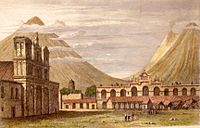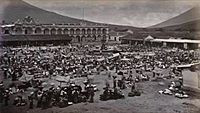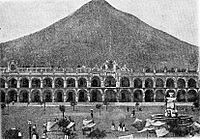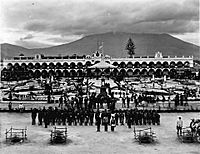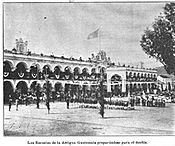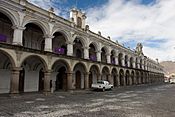Palacio de los Capitanes Generales, Antigua Guatemala facts for kids
Quick facts for kids Captain General Palace |
|
|---|---|
|
Palacio de los Capitanes Generales
Casas Reales Palacio Real |
|
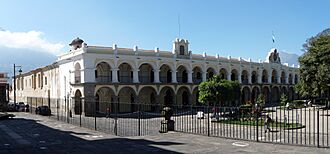
Palace in Antigua Guatemala
|
|
| General information | |
| Location | Antigua Guatemala, |
| Coordinates | 14°33′21″N 90°44′02″W / 14.55583°N 90.73389°W |
| Construction started | 1755 |
| Completed | 1764 |
| Renovated | 1890 |
| Demolished | 1773 |
The Captain General Palace, also known as the Palacio de los Capitanes Generales, is a very old and important building in Antigua Guatemala. It stands proudly in the city's main square. Today, this large building is used by several important groups. It is the home of the Guatemala Institute of Tourism and the Antigua Tourism Association. It also houses the National Police and the government offices for the Sacatepquez Department. You can also find the National Museum of Guatemalan Art inside.
Contents
A Look Back: The Palace's Story
Building a Grand Palace
The first part of this impressive building was started in 1558. It was one of the first two-story buildings in the city. The palace was made with strong wooden floors and beautiful arches. This building was the main office for the government of Guatemala at that time. All the important government, administrative, and military leaders worked here. The Captain General, who was the main leader, lived a very fancy life inside with his family and friends. The building also had offices for taxes, a jail, army headquarters, and storage areas.
By 1678, the Captain General Palace had grown into a grand two-story building. It featured a large wooden main entrance and tall columns.
Earthquakes and Rebuilding
Antigua Guatemala has faced many strong earthquakes over the years. These natural events have often tested the strength of the Captain General Palace.
The San Miguel Earthquake of 1717
In 1717, a big earthquake, called the San Miguel earthquake, shook the city. The Royal Palace, as it was also known, had some damage to its rooms and walls. After this earthquake, some leaders thought about moving the city to a safer place. However, the people of the city did not want to move. They even went to the Palace to show how much they disagreed! The city stayed put, and soldiers were needed to calm everyone down. A skilled builder named Diego de Porres fixed the Palace. He finished the repairs by 1720 and even added more improvements that lasted until 1736.
The San Casimiro Earthquake of 1751
Another strong earthquake, the San Casimiro earthquake, hit the city in 1751. This time, the palace was badly damaged. Its front and upper levels were destroyed. But the strong foundations remained, allowing it to be rebuilt. Construction started in 1755 and was finished in 1764.
The Santa Marta Earthquake of 1773

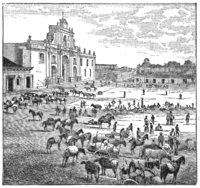
On July 29, 1773, a very powerful earthquake struck the city. It happened around 3:00 p.m. An hour later, an even stronger tremor hit, lasting about a minute. This second quake, along with a big thunderstorm, destroyed many churches, government buildings, and homes. Water and food supplies were also cut off. Many people who supplied the city with food fled to the mountains.
After the earthquake, local leaders met to discuss what to do. They decided to tell the King of Spain about the destruction. They also suggested moving the city to a new valley called "La Ermita." This new location was further away from the volcanoes, which people believed caused the earthquakes.
On December 13, 1773, two more strong earthquakes hit. This convinced everyone that moving the city was the right choice. In 1774, the King's council approved the move. Between 1779 and 1783, a leader named Matías de Gálvez helped organize the big move.
The earthquake caused a lot of damage, but the city being abandoned made things even worse for the palace. On January 16, 1775, workers began taking out all the useful building materials from the damaged palace. These materials were moved to the new capital city. After this, the Palace was left without doors, windows, balconies, or decorations.
The Palace After the Capital Moved
For much of the 1800s, the city of Antigua was mostly empty. Many old monasteries and churches were sold to regular citizens. However, some families eventually returned to Antigua. Because people were living there again, some form of government was needed. Old buildings, including parts of the Palace, were used for offices.
Towards the end of the 19th century, the front of the old Palace was rebuilt. Workers used the large stone columns that had been stored in temporary shelters for almost a hundred years. After this work, the parts of the Palace that were less damaged were reopened. These included the jail and some government offices.
On February 4, 1976, Guatemala was hit by another very powerful earthquake. This earthquake destroyed much of the country's buildings and badly damaged the Palace. Its eastern side had to be taken down. Despite the damage, the Palace, along with the rest of Antigua Guatemala, was recognized as a World Heritage Site by UNESCO in 1979. This means it is a very important place that should be protected for future generations.
Gallery
See also
 In Spanish: Palacio de los Capitanes Generales (Guatemala) para niños
In Spanish: Palacio de los Capitanes Generales (Guatemala) para niños


